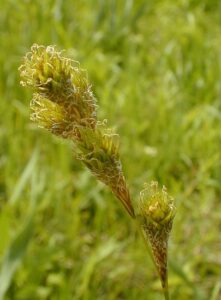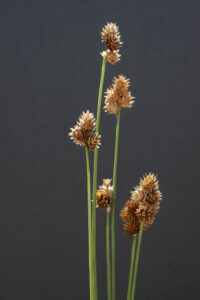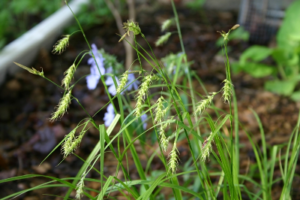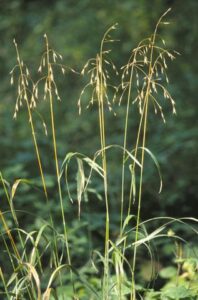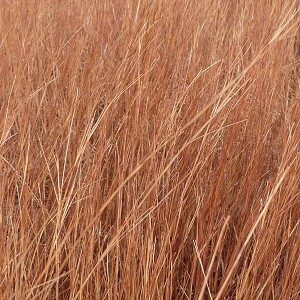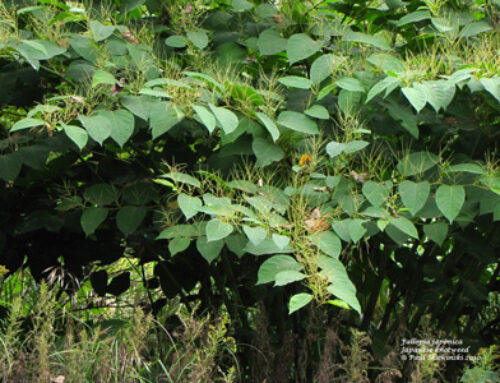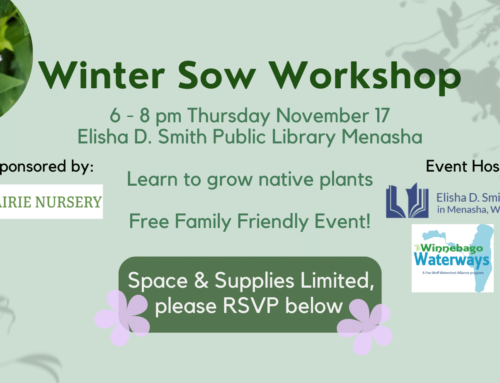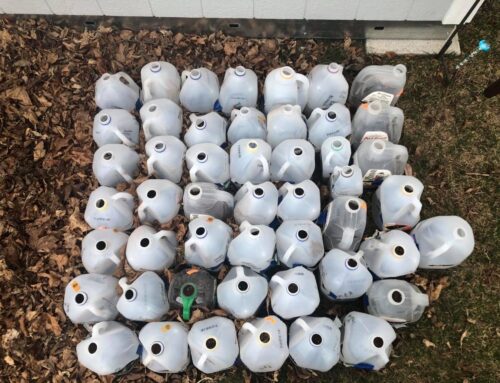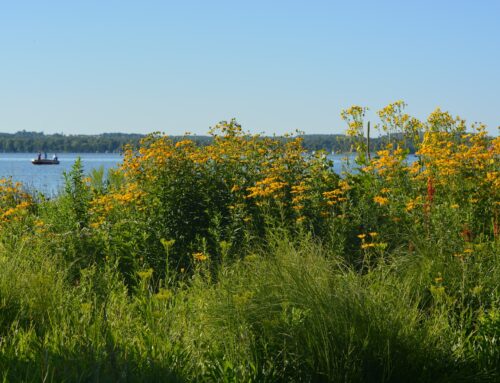One of the things we’ve heard over the last two years is that once native plant projects are installed, that it can be hard to continue to identify the plants present. In April, we starting creating lists of flowers that could be blooming in your native plant project. This list can also be used to help you plan your next native plant project. We have the ability to have plants blooming in our gardens from April to October, so why not make it happen?
Here are the plants that you may see start blooming during the month of June – and by no means is this a complete list.
Sun definitions
Full sun: gets at least 6 hours of direct sunlight
Partial sun: gets three to six hours of sun exposure
Shade: less than three hours of sun exposure
Soil definitions
Wet: Saturated year round
Wet-mesic: Seasonally saturated, tends to dry in summer
Mesic: Medium moisture, well-balanced
Dry-mesic: well-drained
Dry: excessively drained
Anise Hyssop Agastache foeniculum
Anise hyssop can be found blooming from June to September. It has small purple flowers that grow together on stalks. Anise hyssop prefers mesic to dry mesic soils and full to partial sun. It will grow up to 3 feet tall, attracts butterflies, bees, and birds, especially hummingbirds. While no plant is totally deer or rabbit resistant, anise hyssop is not one they prefer.
Leadplant Amorpha canescens
This legume has gorgeous purple flowers that can be found June through August. Leadplant prefers dry, dry-mesic, and mesic soils. It grows best in full to partial sun and can be between one and three feet tall. Leadplant attracts hummingbirds, butterflies, and bees.
Thimbleweed (Anemone cylindrica) and Tall Thimbleweed (A. virginiana)
Thimbleweed blooms in June and July, has small white flowers and grows to be about 2 feet tall. This plant likes its soil to be dry, dry-mesic, or mesic. Thimbleweed prefers full to partial sun. It makes an excellent cut flower and attracts butterflies and birds.
Similar to the thimbleweed, tall thimbleweed can be found blooming June through August and prefers full to partial sun. It prefers slightly drier conditions – dry and dry mesic soils. Tall thimbleweed can grow up to three feet tall, attracts bees and is deer and rabbit resistant.
Poke Milkweed Asclepias exaltataa
The first of a number of milkeed that bloom in June, poke milkweed has white flowers that can be found in both June and July. It grows up to 4 feet tall, likes dry-mesic to mesic soils, and partial sun to shade. Poke milkweed attracts butterflies and bees and is deer and rabbit resistant.
Red Milkweed Asclepias incarnate
Red milkweed is also known as rose milkweed or swamp milkweed. Its red flower can be found blooming from June to August. Red milkweed likes wet, wet-mesic, and mesic soils and full to partial sun. This plant is a great addition to rain gardens! It attracts butterflies and hummingbirds, makes a beautiful cut flower, and is deer resistant. Red milkweed does grow anywhere from 3 to 5 feet so proper placement is necessary.
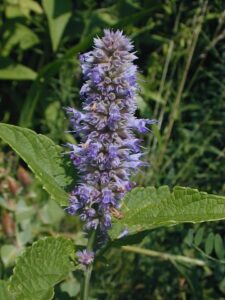


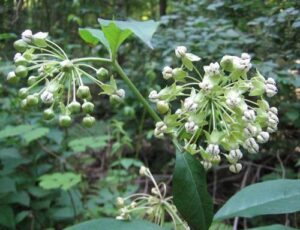
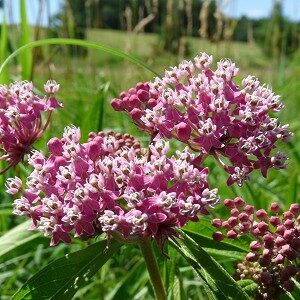
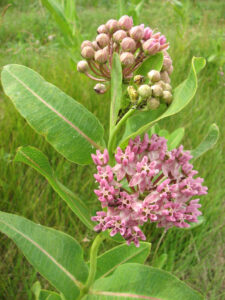
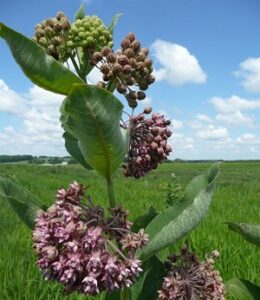

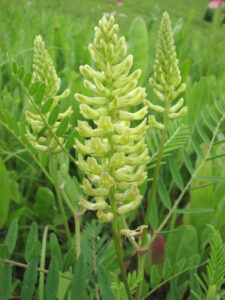

Prairie Milkweed Asclepias sullivantii
Next up on the list of milkweeds blooming in June is prairie milkweed. Prairie milkweed has light pink flowers that can be found from June to August. It loves full sun and wet-mesic to mesic soils. Prairie milkweed grows to be about 3 feet tall and makes a nice cut flower for any arrangement. It attracts hummingbirds, bees, and butterflies.
Common Milkweed Asclepias syriaca
This plant is found growing everywhere! Common milkweed will grow in all soil types but wet and likes full to partial sun. Common milkweed attracts butterflies, makes a great cut flower, and grows to be about three feet tall. If you are looking for monarch eggs or caterpillars this is where you look!
Butterfly milkweed Asclepias tuberosa
Butterfly milkweed and its orange flowers can be found blooming June through September. It prefers slightly drier soils than some of our milkweeds – thriving in dry, dry-mesic, and mesic soils. Butterfly milkweed grows to be about three feet tall and enjoys full to partial sun. It attracts bees, butterflies, and birds – including hummingbirds. It grows well in rain gardens, makes a great addition to floral arrangements and is deer resistant.
Canada Milkvetch Astragalus canadensis
Another June flowering legume is Canada milkvetch. This plant has cream colored flowers that bloom June through August and attract butterflies, bees, and birds – including hummingbirds. Canada milkvetch grows well in all soil types but wet, likes full to partial sun, and grows to be about three feet tall. It is also considered deer resistant.
New Jersey Tea Ceanothus americanus
New Jersey tea is a great native shrub option. It has white flowers that bloom from June to August. It likes dry, dry-mesic, and mesic soils. New Jersey tea grows to be about three feet tall and likes full to partial sun. It attracts birds and butterflies. Native shrubs and trees have a number of benefits for caterpillars and other native insects, so working to incorporate them into the landscape is crucial.
Prairie Coreopsis Coreopsis palmata
Prairie coreopsis blooms from June to August, prefers full to partial sun, and grows to about two feet tall. This yellow flowered plant can be found in dry, dry-mesic, and mesic soils. Deer dislike prairie coreopsis while butterflies are attracted to it.
White Prairie Clover Dalea candida and Purple Prairie Clover D. purpurea
Both of these prairie clovers can be found blooming June through August with white prairie clover lasting until September. Both species like dry, dry-mesic, and mesic soils. White prairie clover likes full to partial sun while purple prairie clover (pictured) needs full sun. Both plants grow to be about two feet tall and attract birds and butterflies.
Early Sunflower Heliopsis helianthoides
Early sunflower is a wonderful option for almost any garden. It likes its soil to be mesic-wet, mesic, or mesic-dry and it grows best in full to partial sun. On the taller side, early sunflower can grow to be anywhere from 3 to 5 feet. It attracts birds and butterflies.
Dotted St. John’s Wort Hypericum punctatum
This native plant can be found blooming any time between June and September. The yellow flowers of dotted St. John’s wort attracts birds and butterflies. It grows to be about two feet tall and grows best in dry-mesic to mesic soils and in full to partial sun.
Wild Bergamot Monarda fistulosa and Spotted Bee Balm M. punctata
Wild bergamot is a beautiful plant with purple flowers that blooms June through August. It grows well in any soil type but wet and likes full to partial sun. Wild bergamot grows anywhere from 2 to 4 feet, attracts butterflies, bees, and birds – including hummingbirds. It is deer and rabbit resistant. In addition to being a pretty native plant, wild bergamot has many medicinal qualities.
Similar to wild bergamot, spotted bee balm has a light purple flower that can be found blooming in June and July. It likes dry, dry-mesic, and mesic soils. Spotted bee balm (pictured) enjoys full to partial sun and grows to be three feet tall. It attracts birds, bees, and butterflies.


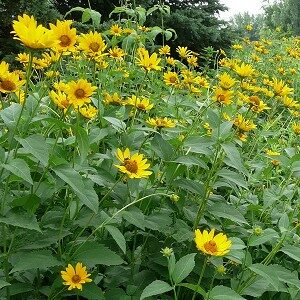

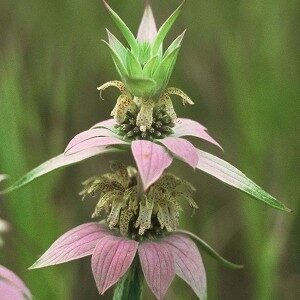

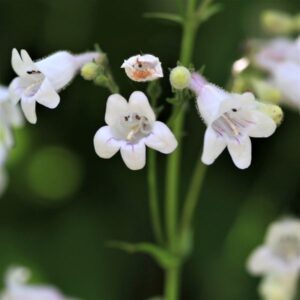



Common Evening Primrose Oenothera biennis
Common evening primrose is another large native plant; it can grow to be six feet tall. Common evening primrose grows in all soil types but wet and needs full to partial sun. It can be found in flower from June to September and attracts birds and butterflies.
Foxglove Beardtongue Penstemon digitalis
Otherwise known as smooth penstemon, this plant can be found flowering from June to September. Foxglove beardtongue has white flowers, grows best in full sun, and likes wet-mesic, mesic, and dry-mesic soils. It grows to be four feet tall so placement is important.
Black-eyed Susan Rudbeckia hirta
Black-eyed Susan is a favorite for many gardeners. It grows to be about two feet tall, likes all soil types but wet and needs full to partial sun. Black-eyed susans attract butterflies and birds. It does great in rain gardens and is deer resistant.
Wild Petunia Ruellia humilis
Wild petunia is a good option for ground cover in native planting projects. It has light blue flowers that bloom June through August. Wild petunia needs full sun but can grow in dry, dry-mesic, and mesic soils. It will attract butterflies and birds, including hummingbirds.
Compass Plant Silphium laciniatum
Compass plant is a fun plant to grow but can get very tall – hitting upwards of 8 feet. It does well in all soil types aside from wet and needs full to partial sun. Compass plant will bring in the butterflies, bees, and birds. It takes a number of years to get a full grown compass plant so be patient.
Meadowsweet Spiraea alba
Meadowsweet is a good addition to rain gardens. Its white flowers can be found blooming from June to August. It likes wet, wet-mesic, and mesic soils and full to partial sun. Meadowsweet attracts butterflies and is deer resistant. It grows to be about three feet tall, so it will fit right in with other rain garden plants.
Purple Meadow Rue Thalictrum dasycarpum
Purple meadow rue, and its cream flowers, can be found growing in wet-mesic and mesic soils. It is considered deer resistant and that may be because it grows to six feet tall! Purple meadow rue needs full to partial sun to grow its best.
Hoary Vervain Verbena stricta
Hoary vervain grows to about two feet tall in dry and dry mesic soils. It has blue flowers that can be found from June to September. It grows best in full to partial sun and makes a great cut flower. Hoary vervain attracts both butterflies and hummingbirds.

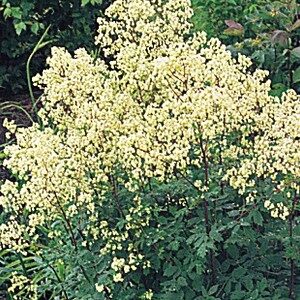
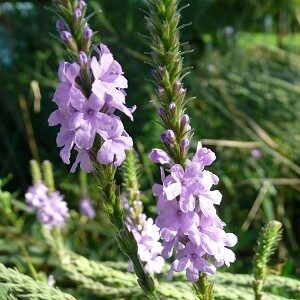
Many sedges and grasses start blooming in June. For ease, we created a couple tables to display their information.
Sedges
| Common Name | Species Name | Blooming Period | Sunlight | Soil type | Height | Other | |
|---|---|---|---|---|---|---|---|
Copper-shouldered Oval Sedge |
Carex bicknellii |
June – July |
Full sun |
Wet-mesic, mesic, dry-mesic |
1-3 feet |
|
|
Oval-headed Sedge |
Carex cephalophora |
June – July |
Full to partial sun |
Dry, dry-mesic, mesic, wet-mesic |
1-3 feet |
Attracts birds and butterflies |
|
Bottlebrush Sedge |
Carex hystericina |
June – July |
Full sun |
Wet, wet-mesic |
1-3 feet |
AKA porcupine sedgeGreat in rain gardens |
|
Long-beaked Sedge |
Carex sprengelii |
June – July |
Full sun, partial sun, shade |
Wet, wet-mesic |
1-3 feet |
Great in rain gardens |
|
Fox Sedge |
Carex stipata |
June – July |
Full sun, partial sun, shade |
Wet, wet-mesic, mesic |
1-3 feet |
Great in rain gardens |
|
Dark-green Bulrush |
Scirpus atrovirens |
June – July |
Full sun |
Wet, wet-mesic |
3-5 feet |
Attracts birdsGreat in rain gardens |
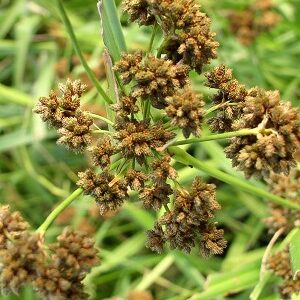 |
Grasses
| Common Name | Species Name | Blooming Period | Sunlight | Soil type | Height | Other | |
|---|---|---|---|---|---|---|---|
Woodland Brome |
Bromus pubescens |
June – August |
Partial sun to shade |
Wet-mesic, mesic, dry-mesic |
4 feet |
AKA Hairy Wood Chess |
|
Silky Wild Rye |
Elymus villosus |
June – July |
Partial sun to shade |
Dry-mesic, mesic, wet-mesic |
3-5 feet |
|
|
June Grass |
Koeleria cristata |
June – September |
Full to partial sun |
Dry, dry-mesic |
2 feet |
|
|
Little Bluestem |
Schizachyriym scoparium |
June – August |
Full sun, partial sun |
Dry, dry-mesic, mesic |
3 feet |
Attracts birdsDeer resistant |
|


